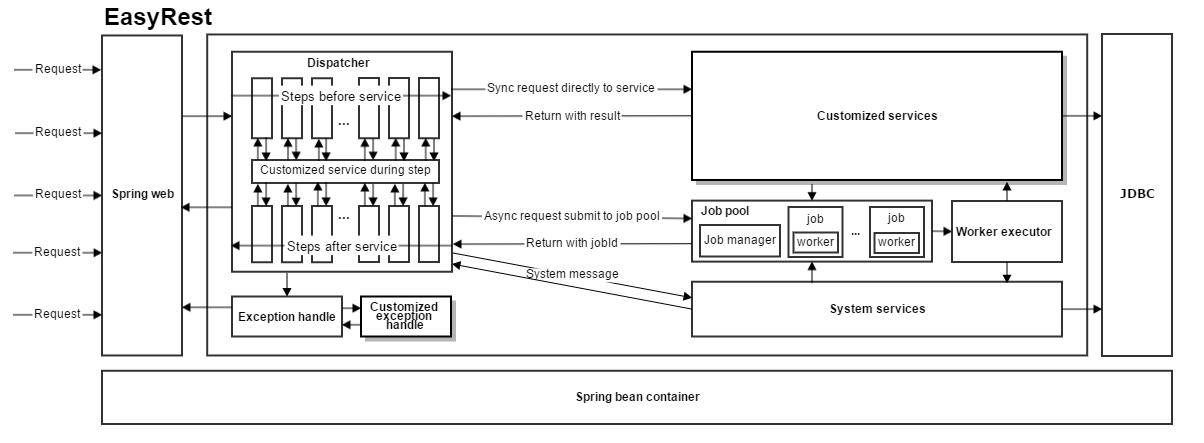Designed for small or medium servers and fast development.
- Request attribute configuration. e.g:charset
- Request method validate.
- Parameters value inject.
- Permission check.
- Missing fields check.
- Customized check.(if required)
- ...
- Other customized step.(if required)
- ...
- Transaction prepared.(if required)
- History record.(if required)
- ...
- Other customized step.(if required)
- ...
- Transaction commit or rollback.(if required)
- Return with the result.
- Submit to job pool and return jobId.
- Query job status.
- Get job result.
- Startup.java
This java file is for the whole system that can config some parameters for this server.
- ExampleModel.java
This is the rest model that defined what parameters we want.
- ExampleServiceImpl.java
This is the implement of the rest.
package com.easyrest.example;
import com.easyrest.framework.easyrest.EasyRest;
import com.easyrest.framework.easyrest.SystemStartupService;
import org.springframework.beans.factory.annotation.Autowired;
import org.springframework.stereotype.Controller;
@Controller
public class Startup implements SystemStartupService {
private static final EasyRest EASY_REST = new EasyRest();
@Override
public void init(){
EASY_REST
.setEnabledAutoTransaction(false)
.setCrossAllow("*")
.setSystemName("MyRestServer");
}
}setEnabledAutoTransaction(false) is the auto transaction switch. If set true, and add @TransactionRequired on the model, the transaction will be auto managed by EasyRest, the transaction can auto start and commit or rollback. You also should add the config in spring applicationContext.xml like:
<bean id="transactionManager" class="org.springframework.jdbc.datasource.DataSourceTransactionManager">
<property name="dataSource" ref="dataSource"/>
</bean>
There are many other configurations will be mentioned on other chapter.
package com.easyrest.example.model.request;
import com.easyrest.example.services.business.rest.HomeServiceImpl;
import com.easyrest.framework.core.annotations.bean.BindService;
import com.easyrest.framework.core.annotations.method.Get;
import com.easyrest.framework.core.annotations.parameter.AllDefined;
import com.easyrest.framework.core.model.request.AbstractRequestModel;
import com.easyrest.framework.core.model.request.HttpEntity;
import com.easyrest.framework.exception.ConditionMissingException;
@Get({"/example"})
@AllDefined
@BindService(HomeServiceImpl.class)
public class ExampleModel extends AbstractRequestModel {
private String code;
private String url;
private String message;
public String getCode() {
return code;
}
public String getUrl() {
return url;
}
public String getMessage() {
return message;
}
@Override
public void customizedCheck(HttpEntity httpEntity) throws ConditionMissingException {
if (url.equals("123")) throw new ConditionMissingException("url can not be 123");
}
}This file is the configuration of the rest.
@Get({/example}) make this rest should use GET method to visit it at the path of "/example".(You can bind multi path on the same rest and also can set GET and POST at the same time).
@AllDefined will check all parameters whether defined in the rest request. If not, EasyRest will return the parameters which not defined.
@BindService(HomeServiceImpl.class) will bind a service to process this rest.
There are many other annotations will be mentioned on other chapter.
package com.easyrest.example.services.business.rest;
import com.easyrest.example.model.request.HomeModel;
import com.easyrest.framework.core.model.request.HttpEntity;
import com.easyrest.framework.core.model.response.ResponseEntity;
import com.easyrest.framework.core.services.business.api.RequestProcessService;
import org.springframework.stereotype.Service;
@Service
public class ExampleServiceImpl implements RequestProcessService {
@Override
public Object doProcess(HttpEntity httpEntity) {
ExampleModel model = (ExampleModel) httpEntity.getRequestModel();
return ResponseEntity.buildOkResponse(model);
}
}This is the service to process the request and bind on ExampleModel.java
The service should to implement RequestProcessService, you can get the HttpEntity which has all infomations about the request and cast it to Model which you bind like this: ExampleModel model = (ExampleModel) httpEntity.getRequestModel(); and all parameters you can get it.
